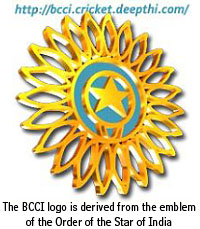

Board of Control for Cricket in India (BCCI)
Full ICC Member since 31 May 1926Latest BCCI News
BCCI is the apex governing body for cricket in India and lays down its law. Follow the links to find comprehensive news and information in BCCI.Board of Control for Cricket in India
| BCCI: Index • Latest News • BCCI related Cricket Polls • Presidents • Secretaries • Contact Info • Indian Cricket History |
Board of Control for Cricket in India
BCCI, India
 The Board of Control for Cricket in India, or BCCI, is the governing body for cricket in India. This is India's richest sporting body. The President of BCCI is Sharad Pawar (elected 29 November, 2005). Niranjan Shah is the secretary.
The Board of Control for Cricket in India, or BCCI, is the governing body for cricket in India. This is India's richest sporting body. The President of BCCI is Sharad Pawar (elected 29 November, 2005). Niranjan Shah is the secretary.
All the office-bearers for the year 2004-05, were elected at the annual general meeting of the Board held in Kolkata.
On January 10, 2005, the Supreme Court of India ordered the removal of Jagmohan Dalmiya from the post of patron-in-chief of BCCI and also asked the board to complete its annual general meeting (AGM) which had been adjourned on September 30, 2004.
The legality of the office-bearer's election at the board's annual general meeting (AGM) held on September 29, 2004 is subjudice.
BCCI Cricket News January 2007
BCCI urges review after South Africa defeat
Jan 08, 2007
Indias cricket board said on Sunday national selectors should be prepared to get tough with struggling senior players in the wake of the Test series defeat in South Africa.
India took a 1-0 lead in the series but sub-par performances from experienced batsmen let South Africa rally to a five-wicket victory in the final Test in Cape Town on Saturday. The Proteas swept the preceding one-day series 4-0 by big margins, also taking advantage of Indias faltering batting, which failed to reach a tally of more than 200 runs once. "The board is definitely concerned by the performance, but it will not interfere," Board of Control for Cricket in India (BCCI) secretary Niranjan Shah told Reuters. "It is up to the selection committee to review things. "(But) the selection committee should not go only by the history of some players," he added. "Consistent performance is important." Indian media and experts have rounded on batsman Virender Sehwag, who made just 89 runs from six Test innings. The 28-year-old Delhi batsman also failed in the one-dayers, raising the possibility of him being left out of the upcoming home one-day series against West Indies and Sri Lanka. Skipper Rahul Dravid also failed to get a fifty in the tests and, with Sachin Tendulkar, took the blame for the batting collapse on day four that led to the final Test defeat. Selectors meet on Friday to pick the 30 probables for the World Cup and the squad for the series with West Indies starting on Jan. 21. Indias poor one-day form has also raised concerns in the build-up to the World Cup, starting on March 13. Coach Greg Chappell criticised the batsmen on Saturday and hinted the performances would be put under the microscope. "Looking at the tour as a whole, there are more questions than answers," he said. "There will be a few guys under a bit of pressure, theres no doubt."
- Board of Control for Cricket in India - December 2006 News
- Board of Control for Cricket in India - November 2006 News
- Board of Control for Cricket in India - October 2006 News
- Board of Control for Cricket in India - September 2006 News
- Board of Control for Cricket in India - August 2006 News
- Board of Control for Cricket in India - July 2006 News
- Board of Control for Cricket in India - June 2006 News
- Board of Control for Cricket in India - May 2006 News
- Board of Control for Cricket in India - April 2006 News
- Board of Control for Cricket in India - March 2006 News
- Board of Control for Cricket in India - February 2006 News
- Board of Control for Cricket in India - January 2006 News
- Board of Control for Cricket in India - December 2005 News
- Board of Control for Cricket in India - November 2005 News
Cricket in India
Cricket is the unofficial national sport of India, and its development has been closely tied up with the history of the country, mirroring many of the political and cultural developments around issues such as race, caste, religion and nationality. Though cricket is indubitably the most popular sport in India, it is not the nation's national sport (a distinction held by field hockey).Cricket, like field hockey, was first introduced to India by the British. The earliest recorded match was played in 17211 by British sailors on shore leave. With the expansion of British rule throughout the subcontinent, the British took the game with them wherever they went. However, the early history of the game was focused largely on the large cities, particularly Bombay (now Mumbai).
The first Indians to play the game at a high level were the Parsi minority in Bombay. Beginning in 1892, an annual match was played between the Parsis and the Europeans. In 1907, this became a triangular tournament with the Hindus fielding a team, and in 1912 a Muslim team entered what was for twenty years the biggest tournament in Indiathe Bombay Quadrangular.
Among the biggest stars in the early years of Indian cricket were the four Palwankar brothers, Shivram, Ganpat and Vithal but particularly the slow left-arm bowler, Palwankar Baloo. This was particularly noteworthy as the Palwankars were from one of the untouchable castes. Treated as equals on the cricket field, off-field they often faced discrimination. This changed slowly; however, Palwankar Vithal did eventually captain the Hindu team in the quadrangular.
The formation of the Board of Control for Cricket in India in 1929 led to a first Test match with England three years later. In 1935, the Ranji Trophy began; it continues to the present as the leading regional tournament in India, with each state fielding a team. The trophy was a deliberate attempt to avoid the communalism of the quadrangular tournament.
The Indian cricket team has won one Cricket World Cup, in 1983. India also reached the finals in 2003, but lost to Australia. In recent years, Indian cricket has been marked by the intense and occasionally violent rivalry with Pakistan. Furthermore, there were several scandals related to match fixing and gambling, but these were not restricted to India; they plagued several different teams.
International cricket in India generally does not follow a fixed pattern like, for example, the English schedule under which the nation tours other countries during winter and plays at home during the summer. Generally, there has recently been a tendency to play more one-day matches than Test matches.
Ranji Trophy
Founded as 'The Cricket Championship of India' at a meeting of the Board of Control for Cricket in India in July 1934. The first Ranji Trophy fixtures took place in the 1934-35 season. Syed Mohammed Hadi of Hyderabad was the first batsman to score a century in the tournament. The Trophy was donated by H.H. Sir Bhupendra Singh Mahinder Baha-dur, Maharajah of Patiala in memory of His late Highness Sir Ranjitsinhji Vibhaji of Nawanagar. In the main, the Ranji Trophy is composed of teams representing the states that make up India. As the political states have multiplied, so have cricket teams, but not every state has a team. Some states have more than one cricket team, e.g. Maharashtra and Gujarat. There are also 'odd' teams like Railways, and Services representing the armed forces. The various teams used to be grouped into zones - North, West, East, Central and South - and the initial matches are played on a league basis within the zones. The top two (till 1991-92), top three teams from each zone then play in a national knock-out competition. Starting with the 2002-03 season, the zonal system has been abandoned and a two-division structure has been adopted with two teams being promoted from the plate league and two relegated from the elite league. If the knockout matches are not finished they are decided on the first-innings lead.Irani Trophy
The Irani Trophy tournament was conceived during the 1959-60 season to mark the completion of 25 years of the Ranji Trophy championship and was named after the late Z.R. Irani, who was associated with the Board of Control for Cricket in India (BCCI) from its inception in 1928, till his death in 1970. The first match, played between the Ranji Trophy champions and the Rest of India was played in 1959-60 with the trophy being instituted in the name of Zal Irani, long time treasurer of the Board of Control for Cricket in India and a keen patron of the game. For the first few years, it was played at the fag end of the season. Realising the importance of the fixture, the BCCI moved it to the beginning of the season. Since 1965-66, it has traditionally heralded the start of the new domestic season. The Irani Trophy game ranks very high in popularity and importance. It is one of the few domestic matches that is followed with keen interest by cricket lovers in the country. Leading players take part in the game which has often been a sort of selection trial to pick the Indian team for foreign tours.Duleep Trophy
The Duleep Trophy competition was started by the Board of Control for Cricket in India in 1961-62 with the aim of providing a greater competitive edge in domestic cricket - because, apart from the knock-out stages of the Ranji Trophy, that competition proved predictable, with Bombay winning for fifteen consecutive years. The Duleep was also meant to help the selectors in assessing form. The original format was that five teams, drawn from the five zones, play each other on a knock-out basis. From the 1993-94 season, the competition has been converted to a league format.Harbhajan Singh Memorabilia
Singh's Magnificent Hat Trick
Own a piece of Indian Cricket History
 On the 1st Day of the 2nd Test, India versus Australia, in March 2001, at Eden Gardens in Kolkata, Harbhajan Singh achieved what no other Indian cricketer had ever done - he snared a magnificent Hat Trick.
On the 1st Day of the 2nd Test, India versus Australia, in March 2001, at Eden Gardens in Kolkata, Harbhajan Singh achieved what no other Indian cricketer had ever done - he snared a magnificent Hat Trick.
Limited Edition Magnificent photographic collage of the three dismissals with the hat trick at Calcutta capturing photograph in each piece being personally signed by Harbhajan Singh. Each piece .encased in a timber frame with Perspex glazing and is supported by A-Tag microchip authentication technology, and comes complete with a Certificate of Authenticity.
 Buy now / Read more / Other cricket memorabilia
Buy now / Read more / Other cricket memorabilia



